Sienna
Sienna (from Italian: terra di Siena, meaning "Siena earth") is an earth pigment containing iron oxide and manganese oxide. In its natural state, it is yellowish brown and is called raw sienna. When heated, it becomes a reddish brown and is called burnt sienna.[2] It takes its name from the city-state of Siena, where it was produced during the Renaissance.[3] Along with ochre and umber, it was one of the first pigments to be used by humans, and is found in many cave paintings. Since the Renaissance, it has been one of the brown pigments most widely used by artists.
| Sienna | |
|---|---|
| Hex triplet | #882D17 |
| sRGBB (r, g, b) | (136, 45, 23) |
| CMYKH (c, m, y, k) | (0, 67, 83, 47) |
| HSV (h, s, v) | (12°, 83%, 53[1]%) |
| Source | ISCC-NBS |
| ISCC–NBS descriptor | Strong reddish brown |
| B: Normalized to [0–255] (byte) H: Normalized to [0–100] (hundred) | |
The first recorded use of sienna as a colour name in English was in 1760.[4]
Earth colours
Like the other earth colours, such as yellow ochre and umber, sienna is a clay containing iron oxide, called limonite, which in its natural state has a yellowish colour. In addition to iron oxide, natural or raw sienna also contains about five percent of manganese oxide, which makes it darker than ochre. When heated, the iron oxide is dehydrated and turns partially to haematite, which gives it a reddish-brown colour.[5] Sienna is lighter in shade than raw umber, which is also clay with iron oxide, but which has a higher content of manganese (5 to 20 percent) which makes it greenish brown or dark brown. When heated, raw umber becomes burnt umber, a very dark brown.[6]
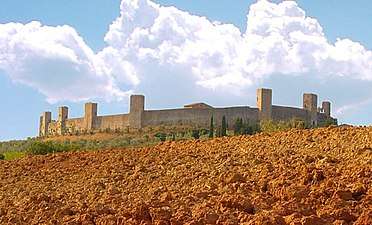 The clay soil of Tuscany (here near Monteriggioni) is rich in limonite, or hydrated iron oxide, the main ingredient of sienna pigment.
The clay soil of Tuscany (here near Monteriggioni) is rich in limonite, or hydrated iron oxide, the main ingredient of sienna pigment.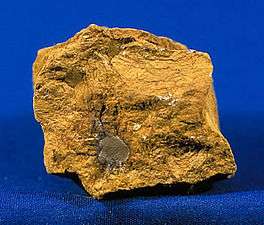 Limonite, a clay containing iron oxide, which gives the color to sienna pigment.
Limonite, a clay containing iron oxide, which gives the color to sienna pigment.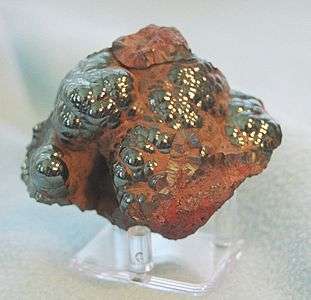
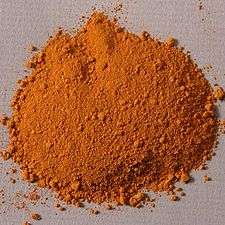 After being heated, the pigment has become the colour known as burnt sienna.
After being heated, the pigment has become the colour known as burnt sienna.
History
The pigment sienna was known and used, in its natural form, by the ancient Romans. It was mined near Arcidosso, formerly under Sienese control, now in the province of Grosseto, on Monte Amiata in southern Tuscany. It was called terra rossa (red earth), terra gialla, or terra di Siena. During the Renaissance, it was noted by the most widely read author about painting techniques, Giorgio Vasari, under the name terra rossa. It became, along with umber and yellow ochre, one of the standard browns used by artists from the 16th to 19th centuries, including Caravaggio (1571-1610) and Rembrandt (1606-1669), who used all the earth colours, including ochre, sienna and umber, in his palette.[7][8]
By the 1940s, the traditional sources in Italy were nearly exhausted. Much of today's sienna production is carried out in the Italian islands of Sardinia and Sicily, while other major deposits are found in the Appalachian Mountains, where it is often found alongside the region's iron deposits. It is also still produced in the French Ardennes, in the small town of Bonne Fontaine near Ecordal.[6]
In the 20th century, pigments began to be produced using synthetic iron oxide rather than the natural earth. The labels on paint tubes indicate whether they contain natural or synthetic ingredients. PY-43 indicates natural raw sienna, PR-102 indicates natural burnt sienna.
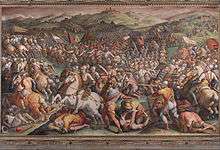 Giorgio Vasari (1511-1574) used earth colors, including ochre and sienna, in his frescos, including this painting in the Hall of the Five Hundred at the Palazzo Vecchio in Florence.[9] In his writings Vasari called sienna terra rossa.[10]
Giorgio Vasari (1511-1574) used earth colors, including ochre and sienna, in his frescos, including this painting in the Hall of the Five Hundred at the Palazzo Vecchio in Florence.[9] In his writings Vasari called sienna terra rossa.[10].jpg)
Variations
There is no single agreed standard for the colour of sienna, and the name is used today for a wide variety of hues and shades. They vary by country and colour list, and there are many proprietary variations offered by paint companies. The colour box at the top of the article shows one variation from the ISCC-NBS colour list.
Raw sienna
| Terra di Siena naturale, or raw sienna (Italian) | |
|---|---|
| Hex triplet | #965434 |
| sRGBB (r, g, b) | (150, 84, 52) |
| CMYKH (c, m, y, k) | (0, 44, 65, 41) |
| HSV (h, s, v) | (20°, 65.3%, 58.8%) |
| Source | Ferrario 1919: Cartella colori, colour 69 |
| ISCC–NBS descriptor | Strong brown |
| B: Normalized to [0–255] (byte) H: Normalized to [0–100] (hundred) | |
Raw sienna is a yellowish-brown natural earth pigment,[2] composed primarily of iron oxide hydroxide. The box shows the colour of the pigment in its natural, or raw state. It contains a large quantity of iron oxide and a small quantity (about five percent) of manganese oxide.
This kind of pigment is known as yellow ochre, yellow earth, limonite, or terra gialla. The pigment name for natural raw sienna from the Colour Index International, shown on the labels of oil paints, is PY-43.
This box at right shows a variation of raw sienna from the Italian Ferrario 1919 colour list.
Burnt sienna
| Terra di Siena bruciata, or burnt sienna (Italian) | |
|---|---|
| Hex triplet | #623034 |
| sRGBB (r, g, b) | (98, 48, 52) |
| CMYKH (c, m, y, k) | (0, 51, 47, 62) |
| HSV (h, s, v) | (355°, 51%, 38.4%) |
| Source | Ferrario 1919: Cartella colori, colour 77 |
| ISCC–NBS descriptor | Deep reddish brown |
| B: Normalized to [0–255] (byte) H: Normalized to [0–100] (hundred) | |
Burnt sienna contains a large proportion of anhydrous iron oxide. It is made by heating raw sienna, which dehydrates the iron oxide, changing it partially to haematite, giving it rich reddish-brown colour.[2]
The pigment is also known as red earth, red ochre, and terra rossa. On the Colour Index International, the pigment is known as PR-102.
This version is from the Italian Ferrario 1919 colour list.
The first recorded use of burnt sienna as a colour name in English was in 1853.[11]
Burnt sienna pigment (Maerz and Paul)
| Burnt sienna (Maerz and Paul) | |
|---|---|
| Hex triplet | #E97451 |
| sRGBB (r, g, b) | (233, 116, 81) |
| CMYKH (c, m, y, k) | (0, 50, 65, 9) |
| HSV (h, s, v) | (14°, 65%, 91%) |
| Source | Maerz and Paul[11] |
| ISCC–NBS descriptor | Strong reddish orange |
| B: Normalized to [0–255] (byte) H: Normalized to [0–100] (hundred) | |
This variation of burnt sienna is from the Maerz and Paul "A Dictionary of Color" from 1930. It is considerably lighter than most other versions of burnt sienna. It was a mix of burnt orange and raw sienna.
Dark sienna (ISCC-NBS)
| Dark sienna | |
|---|---|
| Hex triplet | #3C1414 |
| sRGBB (r, g, b) | (60, 20, 20) |
| CMYKH (c, m, y, k) | (0, 67, 67, 76) |
| HSV (h, s, v) | (0°, 67%, 24%) |
| Source | ISCC-NBS[12] |
| ISCC–NBS descriptor | Dark reddish brown |
| B: Normalized to [0–255] (byte) H: Normalized to [0–100] (hundred) | |
This infobox shows the colour dark sienna. This variation is from the ISCC-NBS colour list. A similar dark sienna paint was frequently used on Bob Ross' TV show, The Joy of Painting.
Sienna (X11 colour)
| Sienna (X11 web colour) | |
|---|---|
| Hex triplet | #A0522D |
| sRGBB (r, g, b) | (160, 82, 45) |
| CMYKH (c, m, y, k) | (0, 49, 72, 37) |
| HSV (h, s, v) | (19°, 71.9%, 62.7%) |
| Source | X11 |
| ISCC–NBS descriptor | Strong brown |
| B: Normalized to [0–255] (byte) H: Normalized to [0–100] (hundred) | |
The web colour sienna is defined by the list of X11 colours used in web browsers and web design.
See also
- Clay earth pigment
- List of colours
- List of inorganic pigments
References
- web.forret.com Color Conversion Tool set to hex code of color #882D17 (Sienna)
- Shorter Oxford English Dictionary, 5th Edition (2002)
- Webster's New World Dictionary of the American Language, College Edition, (1964)
- Maerz and Paul A Dictionary of Color New York:1930 McGraw-Hill Page 204; Color Sample of Sienna: Page 37 Plate 7 Color Sample E12
- Wilcox, Michael (2002). Blue and yellow don't make green. School of Color. pp. 172, 161. ISBN 0-9679628-7-0. Retrieved October 19, 2009.
- Roelofs, Isabelle (2012). La couleur expliquée aux artistes. Groupe Eyrolles. ISBN 978-2-212-134865. p. 30
- John Burnet (1880), A Treatise on Painting in Four Parts, (Google Books)
- David Bomfeld, Christopher Brown, Ashok Roy, (1988) Rembrandt- Art in the Making - Rembrandt. Yale University Press, (ISBN 978-0-300-06145-1).
- Web exhibits, Pigments through the Ages.
- Giorgio Vasari, Lives of the Most Eminent Painters, Sculptors and Architects. (Google Books).
- Maerz and Paul A Dictionary of Color New York:1930 McGraw-Hill Page 204; Color Sample of Sienna: Page 33 Plate 5 Color Sample F12
- Foster, John C.; Texas Precancel Club (1 April 2006). "THE MOTHER OF ALL HTML COLOR CHARTS RGB order page #3C (Part of the ISCC-NBS color list)". Archived from the original on 22 November 2012. Retrieved August 16, 2012.